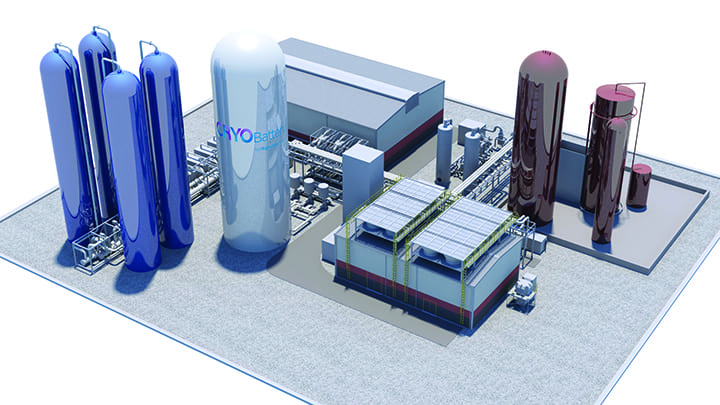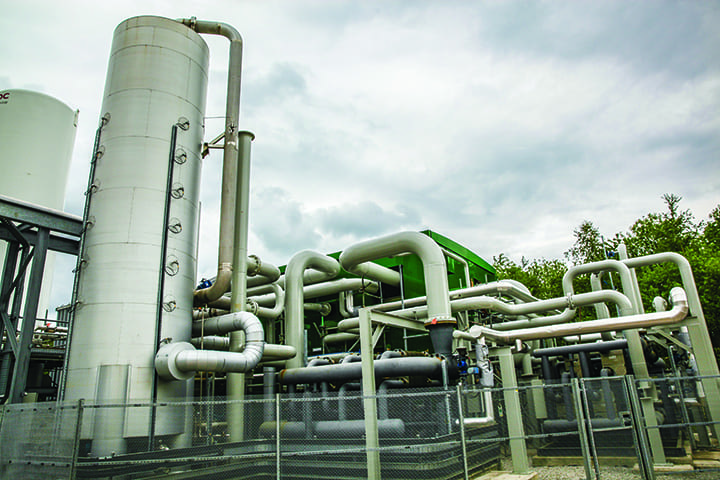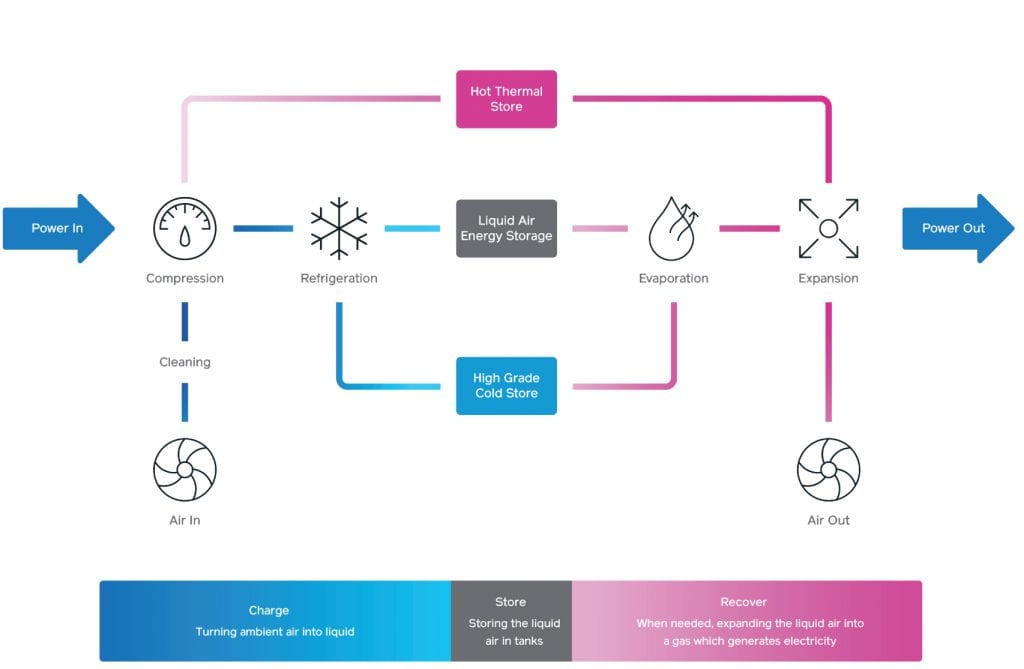Market Prospects Heating Up for Cryogenic Energy Storage
The post Market Prospects Heating Up for Cryogenic Energy Storage appeared first on POWER Magazine.

Highview Power, developer of a cryogenic energy storage system, in April selected MAN Energy Solutions to provide the liquid air energy storage (LAES) turbomachinery train for its 50-MW/250-MWh CRYOBattery facility that is under construction in Carrington Village, just outside Manchester in the UK, and slated to begin operations in 2022. The development marks a new, important milestone for the pioneering LAES project-Highview Power's first commercial plant. According to Dr. Javier Cavada, CEO of Highview Power, the company is now developing dozens" of other projects in the UK, the U.S., Chile, Australia, and Spain, leveraging substantial interest from a major Japanese backer, as well as $70 million in recent investments for growth capital, along with funding and government grants.
Cryogenic energy storage leverages a thermodynamic cycle to essentially turn air in its gas phase to liquid when cooled down to -196C (-320F), Cavada explained in a recent interview. The liquid can then be stored efficiently in heat-insulated, low-pressure vessels. When heated back up to the ambient temperature, it undergoes rapid regasification, prompting a 700-fold expansion in volume that can then be used to drive a steam turbine-really an air turbine' " that is commonly used in steam-generating power plants, he said.
A big draw for the technology (Figure 1) is that it's mechanical, which means it uses already mature, off-the-shelf components sourced from oil and gas liquefaction and power generation original equipment manufacturers. The real innovation is that it uses engineering processes that are well known to give them a new application, which is stored energy," he said.
 |
1. Highview's cryogenic energy storage system comprises three primary processes: a charging system, an energy store, and power recovery. Courtesy: Highview Power |
While the company's CRYOBattery technology derives from a liquid air engine invented in the early 2000s by engineer Peter Dearman, it was developed in partnership with researchers at the University of Leeds starting in 2005. Between 2011 and 2014, Highview Power tested the technology at a 350-kW/2.5-MWh pilot plant at SSE's biomass plant at Slough Heat and Power in Greater London. Then, in April 2018, in collaboration with renewable energy firm Viridor, it began operating a larger, grid-connected 5-MW/15-MWh plant, using low-grade waste heat from GE Jenbacher gas engines at the Pilsworth Landfill facility (Figure 2) in Bury, Greater Manchester, to demonstrate how cryogenic energy storage can provide balancing services.
But though its development began with the coming surge of renewables embedded in its DNA," the technology's functionally in a changing grid has become more crucial as more utilities seek long-duration energy storage, mainly because the CRYOBattery offers key advantages over existing energy storage technologies, Cavada suggested. Cryogenic energy storage essentially serves as complementary technology like a pumped hydro plant, but with big differences-that you can locate it anywhere." It requires no water, produces no emissions, and it's scalable, he said.
 |
2. Highview Power began operating its 5-MW/15-MWh Pilsworth Grid-Scale Demonstrator Plant at the Pilsworth Landfill facility in Bury, Greater Manchester, in April 2018 to demonstrate how liquid air energy storage (LAES) can provide a number of balancing services. Courtesy: Highview Power |
Unlike chemical storage, meanwhile, the bigger [a facility] is, the lower the cost is. So, you can install an enormous amount of air in liquid form, and then the cost-the dollars per megawatt-hour-will get lower exponentially." A 50-MW, six-hour duration installation, which is the company's most commonly offered size, hits the point of inflection" to get costs below lithium-ion's, but at 10, 12, and 16 hours, you're at a portion of the cost of lithium-ion," he said.
Highview Power's portfolio currently extends to 200-MW/2-GWh systems, and while even bigger installations are possible, so far, technology development has catered to market trends for smaller, decentralized plants, Cavada said. But large or small, the technology's small footprint is a key selling point. As an example, a 100-MW/4-hour lithium-ion project is occupying three times more than a 100-MW project with our technology. To go from four hours to eight hours, we need the same space within the same area," he said.
Another key benefit: a service life of 30 to 40 years. Again, component-wise, it's a standard [rotating equipment] system. Everything is recyclable, no fire hazards. Everything is coming from a circular economy, including components of labor, with skill sets coming from the oil and gas industry," he said.
| Cryogenic Energy Storage: A Three-Stage Process Like all energy storage systems, London-based Highview Power's cryogenic energy storage system essentially comprises three main processes: a charging system, a storage phase, and a discharge phase.
In Stage 1, the charging system (which consists of an air liquefier) uses electrical energy to draw air from the surrounding environment and then cleans it and cools it to subzero temperatures. In Stage 2, the liquid air is stored at low pressure in insulated tanks-using widely deployed equipment for bulk storage of liquid nitrogen, oxygen, and liquefied natural gas. In Stage 3, when power is required, the liquid air is drawn from those tanks and pumped to high pressure using stored heat from the air liquefier. The heat is applied to the liquid air via heat exchangers and an intermediate heat transfer fluid. But as crucially in that stage, the very cold air is exhausted and captured by our proprietary high-grade cold store," Highview Power says. This is used at a later time to enhance the efficiency of the liquefaction process." Our storage phase is simply tanks, which store heat and cold in various mediums. The turbomachinery is found in both the charge and discharge phases, these are large air compressors in the charge device which drive the industrial refrigeration cycle (Claude cycle) to liquefy the air, and a large multistage expansion turbine (typically an axial steam turbine derivative) in the discharge device," the company explained. In more detail, the charging device is effectively a modification of an air liquefaction process commonly seen on air-separation plants in the industrial gases sector. This consists of two centrifugal integrally geared compressors, one feed or main air compressor pulling air from the atmosphere, and a second recycle air compressor which drives the refrigeration cycle. Other turbomachinery in this charge cycle includes a smaller cryogenic expander which provides the bulk of the cooling." The discharge device, meanwhile, consists of a multistage axial expansion turbine. Liquid air is drawn from the storage tank and pumped to high pressure before being evaporated and then further heated using heat initially from a packed bed gravel store (evaporation) and then heat from compression captured in the charge phase, before expanding through the axial turbine and out to the atmosphere," it said. |
Construction of the Carrington CRYOBattery project at the Trafford Energy Park, which began in late 2020, involves two phases. Under Phase 1, Highview Power will install a stability island" to provide near-instantaneous" energy grid stabilization. This will be achieved using a generator and flywheel, among other components. Enabling short-term stabilization will provide the basis for Phase 2 and the completion of the more complex liquid air energy storage system that includes various compressors, air expanders and cryogenic equipment," the company explained.
Phase 2 involves the integration of the stability island into the complete cryogenic energy storage system. As announced in April, MAN will provide the turbomachinery train, which will form the core of the CRYOBattery facility." If completed as expected by 2022, the project will offer a blueprint for future projects and cement the partnership between MAN Energy Solutions and Highview Power," Highview Power said.
MAN's involvement is notable because it suggests a pathway toward standardization. Highview Power is confident that CRYOBattery efficiencies and costs will be competitive in shifting markets. As the company notes, while turbomachinery efficiencies will benefit from scale, its efficiencies also vary depending on energy inputs. The company's standard cycle configuration-which the Carrington facility will employ-uses only an alternating current (AC) electrical energy input to operate its industrial air liquefier's compressors and expansion devices. The standard configuration does not require an input of external thermal energy-because it uses heat recovered from the refrigeration process, the company said.
However, an alternative system could integrate high-grade waste thermal energy from an external source, such as waste cold from industrial processes such as liquefied natural gas terminals," it says. Third-party validation from DNV-GL suggests that without the use of external thermal energy, the cycle has a roundtrip efficiency of at least 55%. An LAES system configured to receive high-grade waste thermal energy from an external source could achieve roundtrip efficiencies of 65-75%." That refers to the quantity of electrical energy that can be recovered from a unit mass of liquid air compared to the quantity of electrical energy used to produce a unit mass of liquid air," it explained. While not a complete accounting of the external energy inputs to this type of system, since the thermal energy in such a configuration generally has no economic value, efficiency stated in this way is usually sufficient for economic evaluations."
A Growing Slate of Grid-Critical ApplicationsThe technology's value will also be determined by how it will be applied. While construction at the Carrington plant is ongoing, Highview Power and Encore Renewable Energy are also jointly developing a 50-MW/400-MWh LAES plant in northern Vermont, looking to put it online in 2023. Providing in excess of eight hours of storage," that facility could resolve longstanding energy transmission challenges surrounding the state's Sheffield-Highgate Export Interface (SHEI) and enable the efficient transport of excess power from renewable energy sources to help integrate them on the power grid and to the area's transmission system," Encore says. Additionally, it could provide grid synchronous inertia, market arbitrage, frequency management, reserve, and grid constraint management services."
On May 19, meanwhile, the company publicly announced it will develop up to seven CRYOBattery projects ranging from 50 MW/300 MWh in Asturias, Cantabria, Castilla y Leon, and the Canary Islands, in Spain with partners TSK and the Center for Energy, Environmental and Technological Research (CIEMAT). As Cavada noted, these projects may be boosted by Spain's April 2021 proposed capacity remuneration mechanism, a measure that would enable Spanish transmission system operator Red Electrica de Espana to secure backup capacity to ensure reliability as its share of renewables ramps up to meet an aggressive renewables target of up to 50 GW of installed wind and 39 GW of solar by 2030. The new capacity market could also enable the country to meet targets to increase its storage capacity from 8.3 GW-which is today mainly from pumped hydro and concentrated solar power-to 20 GW of storage capacity in 2030, Cavada said.
There is no grid that doesn't demand storage, but the key commercialization milestone for our technology, market by market, is the existence of a regulation that rewards [capturing surplus power,] storing that energy and delivering it later with a lot of different services and capabilities," he said. Our technology has big masses of rotating equipment-from the compressors to the air turbine to the generator-that provide inertia that's synchronized with the grid, providing reactive power, and providing balancing capabilities to the grid," he added. In the UK, the company's technology runs 24 hours a day, seven days a week to provide balancing, he said.
But the technology is also suited to niche applications for decentralized power, such as at mines in Chile. Yet another emerging application is for resilience. Most projects Highview Power is currently developing are in nodes where there are constraints or weaknesses in the transmission lines, so we are able to capture all those congestion excesses, wastes, reutilizing them later," Cavada said. But at the same time, we are like that emergency generator," serving like a diesel engine-though without the combustion.
The systems can be sited in constrained areas without requiring an external fuel supply that can be a source of failure, which Cavada noted, was a major issue in Texas and the Midwest this February. The service Highview Power is proposing is critical optionality," he said. You could call it a strategic reserve, but in this sense, we can use the strategic reserve for three days, for two days, but we can have storage for 10 hours also," Cavada said. Key to that application, however, will be to scale the technology up.
Investment EnthusiasmSo far, Highview Power's value proposition has attracted interest from notable backers. The largest among them is Japanese conglomerate Sumitomo Heavy Industries, which in February 2020 snagged a $46 million minority stake in the company. Sumitomo told POWER it will use its energy industry experience and worldwide delivery structure to support Highview Power's growth strategy, but because it has a license to the CRYOBattery technology, it will also work to actively develop and execute projects for new and existing clients, in markets where Highview Power is not present or active. Sumitomo said its enthusiasm for the technology stems from its potential solutions to several problems that underlie existing long-term and short-term energy storage schemes.
Since battery modules lose about 2% of their storage capacity each year and need to be replaced every 8-10 years, plant life cycle cost become overwhelming for a large-scale plant. In addition, their cradle-to-grave environmental impact starting from the mining of lithium, cobalt and nickel to the disposal of spent modules, remains a big open question, as well, as their fire safety concern related to overheating," Sumitomo said. A CRYOBattery plant compares very positively to this since it uses only conventional recyclable steel materials and has a lifetime of 30 years," it said. These features give CRYOBattery a very low technology risk," as well as a high reliability and a competitive life cycle cost," the company said.
Looking ahead, Highview Power will leverage $70 million from its first growth capital round of funding, which it closed this February, to develop a late-stage pipeline of over 4 GWh of projects across the U.S., Europe, and Latin America." Cavada noted this is in addition to its current project portfolio of a combined 700 MWh.
Investors participating in the recent growth capital funding round include Janus Continental Group, whose UK-headquartered independent power producer subsidiary Great Lakes Africa Energy has licensed Highview Power's CRYOBattery technology and plans to co-develop renewable-plus-storage projects across the Great Lakes and Southern Africa regions. Outside of Spain, meanwhile, global engineering, procurement, and construction firm TSK says it is working with Highview Power to develop long-duration energy storage systems using the company's energy storage solution in the Middle East and South Africa. Highview Power, notably, will also launch a new capital raise" in the summer 2021 that is 10 times larger than what we did last year," to bolster its growing pipeline of equity ready" projects, Cavada said.
According to Colin Roy, chairman of the Highview Power board and a seed investor, these efforts cater to a tremendous need and demand for long-duration energy storage. Leading utilities are starting to issue [requests for proposals] for 10 hours of storage to be cycled every day," he noted. Grid operators are starting to issue long-term contracts for the provision of synchronous stability services and constraint management. This is what is needed to make the energy transition a realistic proposition. And these things liquid air does better than any other storage system."
-Sonal Patelis a POWER senior associate editor (@sonalcpatel,@POWERmagazine).
The post Market Prospects Heating Up for Cryogenic Energy Storage appeared first on POWER Magazine.
 Highview Power's liquid air technology draws on
Highview Power's liquid air technology draws on